Introduction
by Orchid News
The
professors José Luiz de Andrade Franco, historian, doctor of social
history and history of ideas, and José Augusto Drummond, social
scientist, master of "environmental science" and Ph.D. in Natural
Resources and Development, dedicated two works to Hoehne.
The first work is named "Frederico Carlos Hoehne: the actuality of
a pioneer in the field of nature protection in Brazil", 2005,
published in "Ambiente & Sociedade. Vol.8 nº1, Campinas
- SP" and the second is the book "Nature Protection and National
Identity in Brazil, 1920-1940", edited by Editora Fiocruz - 2009.
In the last one, they approach the import role played by a group of naturalists
in the formulation of policy concerning the conservation of the natural
Brazilian wealth between the decades 20 and 40, discussing the contributions
of e Alberto José Sampaio, Armando Magalhães Correia and
Cândido de Mello Leitão.
The entire chapter 4 is devoted to (Frederico Carlos Hoehne and the nature
conservation in the state of São Paulo).
When someone talks
about Hoehne, we immediately though about his studies on Orchidaceae family,
however he went far beyond as can be seen in the two works mentioned.
Worried about forgetfulness
of scientist, the authors emphasize: "Dead for less than 50 years,
over thought and action of Hoehne, already dropped a troubled cloak that,
if not of a forgetfulness, it is ignorance. In terms of memory, ignorance
may be the eve of oblivion. His thinking, most part forgotten, should
be recovered and examined more closely".
Since long time ago, we have the intention to pay homage to Hoehne, but
faced with these well crafted and full texts, we prefer to ask permission
from the authors to adapt and publish them in Orchid News giving our little
contribution to reduce the ignorance, and consequently, avoiding forget
Frederico Carlos Hoehne.
Orchid News.
"Frederido Carlos Hoehne, a pioneer of nature conservation
in Brazil"
Adapted by
Delfina de Araujo
Frederico
Carlos Hoehne was a pioneer in nature protection among Brazilian scientists
of the twentieth century.
As a prolific and influential scientist, writer and manager of scientific
institutions, participant in organizations in the scientific community,
Hoehne contributed to the emergence of environmental awareness in Brazil.
He transmitted his knowledge about the Brazilian nature and his concern
with its preservation for generations of Brazilian scientists, decades
before the environmental questions arose in an institutionalized form
in the conscience of the contemporary citizens.
From the public defense of his positions, he took on particular importance
among Brazilian people who were concerned about the protection of nature
in the years 1930-1940. It happened in a time of scarce investment in
science.
Hew was one of the first Brazilian to undertake systematic comprehensive
and long-term studies about our native flora or about any associated matters
such as biogeography and ecology. He spent decades studying the flora
continuously, alternating their field trips with extended periods of laboratory
work, herbarium and research institutions in Brazil. Traveling throughout
most of the country, he denounced the procedures that contributed to the
devastation of forests and bad land use.
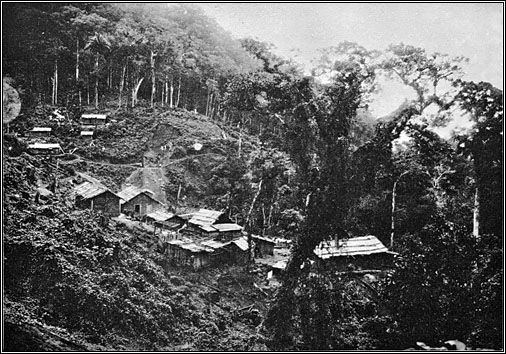 |
| “Primary
Forest between Jussural and Angra dos Reis, State of Rio de Janeiro,
that we visited in 1926. Here one can see how the railroads, since
they are built,contribute to destroy the forests they cross. A camp
where we stayed for 8 days studying the flora and the conditions where
the Orchidaceas thrive in our country.” (Album
de Orchidaceas Brasileiras). |
In a few words, he allied an extensive field experience with the formation
of plant collections that formed the basis for studies of other scientists.
He produced numerous influential publications, giving an important contribution
to the scientific knowledge of flora. He left a legacy that helped and
still helps in the formation of new generations of Brazilian natural scientists,
many of whom, in many ways, have engaged or engage themselves in efforts
to know and preserve the nature of the country. His approach combined
the aesthetic and scientific arguments with national identity. For him
was crucial that human been act in harmonious way with the nature that
surrounds them, trying to know and admire it.
Born and raised in Minas Gerais with a self-taught formation, during his
long career, reached the status of scientist of national and international
reputation. Besides being a first-rate researcher, he managed to articulate
and communicate a perception very sensitive towards nature and its diversity,
using both aesthetic and pragmatic arguments in order to preserve them.
He argued that the preservation of native forest propitiated habitats
for birds, insects and other animals that protect agriculture from predators
and parasites. These perspectives, for sure, are now supported and complied
with in any conference on bio diversity and the preservation of the natural
environment, even by scientists who could never read Hoehne
Already in the 20s of last century, he pondered and warned of human actions
regarding to the nature:
"... the man is entitled to dispose of trees, as all that nature
offers, as he sees fit, but with this, we can not grant rights to individuals
to the detriment of the collective right. (HOEHNE, apud Dean, 1996:
274).
"... what nature has created, once destroyed, can never be made
artificially and... in forests and grasslands we still possess thousands
and thousands of plants and animals that we do not know but maybe one
day become very important and useful for us" (HOEHNE, apud DEAN,
1996: 274).
His nationalism was a bet on the possibility that Brazil would correct
the directions regarding to dealing with nature and, through his own plans
to reconcile human activities with nature. To him, countries with
more advanced economies lost their tutelary role in this dimension, serving
us, at best, only as a warning signal, since, ""deprived
land of its primary and native forests, people now try to reestablish
the biota and excellent conditions by means of natural forests, without
achieving it"" (HOEHNE, apud DEAN, 1996: 274).
He found necessary, therefore, safeguard the natural property of the nation.
Patriotism and appreciation of nature, not only from an economic standpoint
but also from a perspective involving the scientific interest and aesthetic
sensibility, were seen as necessary foundations of national identity and
ensure perpetuation of the natural legacy.He saw the devastation of nature
in Brazil as a result of ignorance or bad faith and selfishness of those
who only aims for immediate profit. It was therefore necessary to provide
information about the conservation of nature and its resources to an audience
as broad as possible, and ensure the development of laws which were subject
to guarantee interest to the public benefit.
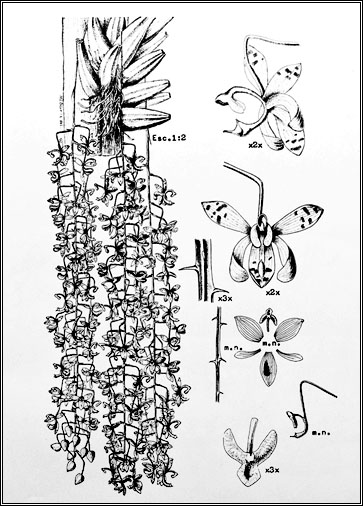 |
| Cirrhaea longiracemosa Hoehne |
Cirrhaea longiracemosa
Hoehne is
a species with a wide distribution occurring since the state of Santa Catarina
until the state of Bahia, including Paraná, Espírito Santo
and Rio de Janeiro.
"Known as a 'bunch of wasps' or 'bunch of small mosquitoes' due to
the appearance of its flowers and their arrangements in the rachis of the
inflorescence. With the movement of the breeze, there is a slight movement
of the segments which resembles the wasps or small mosquitoes resting”
(Hoehne, Iconografia das Orchidaceaes do Brasil – 220)
His concern for the preservation of species and biological diversity made
him early on, defending the need for the establishment of a gene reserve
of native flora and fauna. At the federal level, his ideas helped to create
the first national parks in Brazil. At the state level, was directly involved
in the creation of the Botanical Garden of São Paulo. In the 1930s,
was edited a law relating to the protection of nature and created some
natural conservation areas. He recognized the importance of these measures,
although he complained of the lack of observance of the laws that support
them. In his opinion, it was essential that regarding to the preservation
of nature, individual interests should be subordinated to the community
and thought having in mind the future generations.
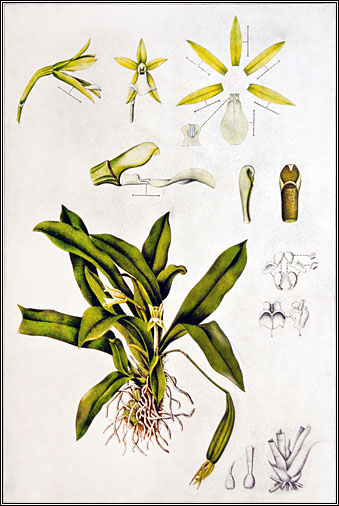 |
Hoehneella gehrtiana (Hoehne) Ruschi
Hoehneella Ruschi, a genus in his homage |
Hoehne
was not a preservationist "strictu sensu". He defended the use,
provided prescient, of natural resources, as well as aesthetic enjoyment
and scientific research, which should be guaranteed by human artifice
in partnership with nature, was in favor of production in a manner which
we would now call sustainability. Cities with trees and flowers, interspersed
with parks and gardens, roads interspersed with forest reserves, all were
planned in his projects.
Despite all this contribution, he is part of a legion of recent voices
almost forgotten who manifested against the irrational deal with Brazilian
nature. Dead for less than 50 years, over thought and action of Hoehne,
already dropped a troubled cloak that, if not of a forgetfulness, it is
ignorance. In terms of memory, ignorance may be the eve of oblivion. His
thinking, most part forgotten, should be recovered and examined more closely.
His biography
Frederico Carlos Hoehne was born in Juiz de Fora (MG) on 1/2/1882 and
died on 03/16/1959. He grew up in rural place near his hometown in the
domain area of the Atlantic Forest, where, he said, was born the "base
for [my] interest in botany. "
After completing high school and not having access to a college that interested
him, at 17, he started a self-study and go on observing the plants. He
purchased books and expanded his collection of plants, making effort to
identify and classify them, already longing for discovering new species.
In spiting of having no scientific training, in1907, aged 25, he launched
his career as a researcher and scientist when he was named for the post
of Chief Gardener of the National Museum of Rio de Janeiro, the largest
scientific institution in the country. Shortly thereafter he was invited
to participate in an expedition of naturalists of National Museum who
would joined Candido Mariano da Silva Rondon on a trip to Mato Grosso.
In 1917, he moved to Sao Paulo and settled professionally developing a
systematic action and long duration, in relation to the study and protection
of nature. In that state, was ahead of many institutions related to botany
and his career was closely linked to the emergence of the Institute of
Botany of São Paulo, since joining in 1928, by this time, the Institute
for Biological Agricultural and Animal Defense. Finally, in 1942, after
several changes, this institution became the current Institute of Botany,
where he worked until 1952 and is retired, compulsorily when reached the
age of 70.
His Works:
For Hoehne the production of knowledge pure and simple was not sufficient,
it was necessary to make it known. He wrote over 600 scientific articles
and diffusion approaching different subjects such as forest reserves and
biological stations, ornamentation of streets, city parks and highways,
with the protection and planting of native species, reforestation, forest
protection, with emphasis on need for legislation to protect nature, fighting
habits of slash and burn, the protection of forests in general determinant
agents for the climate, agriculture, aesthetics and conservation campaigns.
His contribution extended to other productions, such as lectures, conferences,
booklets for children and various texts of limited circulation.
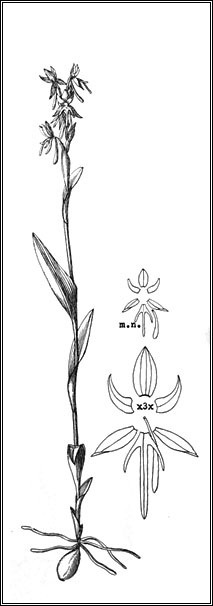 |
Habenaria ernestii-ulei Hoehne
Species described from a plant found in "Serra de Itatiaia",
Rio de Janeiro, at 2.000m |
In the current
Institute of Botany, he devoted himself to mapping and survey of flora
and published several volumes of this work, which he entitled Flora Brasílica.
This work consists of 12 issues which 4 of them (Volume 1, 5, 8 and 10)
approach the Orchidaceae family, making it one of the most important and
most complete information about this group of plants, published in Brazil.
About this family, besides this collection, and numerous articles and
trip reports, he published "Iconografia das Orchidaceas do Brasil
e Álbum de Orchidaceas Brasileiras". His work, too wide, won
widespread national and international recognition. Many institutions paid
homage to him and we should point out the the invitation to participate
as an honorary member of the American Orchid Society, a distinction given
to few scientists worldwide, and the title of doctor honoris causa given
by the University of Gottingen in Germany in 1929.
Travels and Orchids
In mid-1908, he left for what would be the first of his many research
trips to many parts of Brazil. In late 1909, returned from Mato Grosso
bringing 2,000 plants collected in various locations so remote state,
which were incorporated in the herbarium of the National Museum. He sent
many floristic specimen to Germany for identification. His drawings (of
plants) were also printed in Germany and then attached to the official
report of Rondon's excursion.
In 1910, he was back in Mato Grosso, in the company of botanists and Hermano
Geraldo Kuhlmann, in a new excursion for studying the flora.
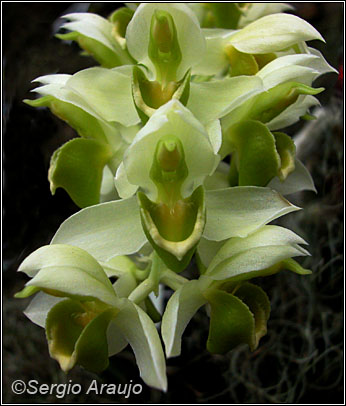 |
| Among the
several species described by Hoehne Catasetum, three of them occur
in the state of Mato Grosso, as Catasetum cirrheaoides Hoehne
|
In 1912, he was again, the botanist of Rondon expedition (Mato Grosso
and Amazonas) and in 1913 played the same role in so-called Roosevelt-Rondon
Scientific Expedition. It means, in just over five years, he made four
long voyages of scientific exploration.
Between
1908 and 1948, he participated in 15 scientific expeditions to Brazil
and some neighboring countries. The travels took him, among other places,
Mato Grosso, Minas Gerais, Sao Paulo, Rio de Janeiro, Parana, Santa Catarina
and the southern Brazilian coast. in these expeditions at least 10,000
plant specimens were collected, representing at least 4,000 different
species, of which about 200 were new to science.
The expeditions made by Hoehne in Brazil, as well as his knowledge and
his concerns about the native flora and fauna, have been synthesized in
the "Iconografia das Orchidáceas do Brasil" (Hoehne,
1949b), in the chapter "mental tour around the country". It
is, basically, to elucidate what, where and how they live orchids in Brazil.
However, while we go along the author in the proposed trip, other more
general subjects related to the phytogeography and the protection and
rational use of nature are discussed. In principle it was agreed that:
“"No other country has a greater variety of reasons than
ours. Our forests and grasslands bearing vines and herbs with flowers
more beautiful and more lovely than those of Acanto of Greece and shelter
orchids with flowers more beautiful and artistic than all roses from Bulgaria
and Italy. Why let the artists take us into strange lands the privilege
of introducing them in the decorative art of bas-relief, bars, Greek and
plated as wallpaper and decorations in stucco? It is urgent and very appropriate
that we turn our sights to all these wonders of indigenous nature and
use them in the arts, gardens, parks and halls. In doing so we engage
in patriotic work, because we compete for our land learn to appreciate
them, to love her, not only because it produces the intellectual side,
but also by what is born and comes spontaneously from his abundant ground"
(HOEHNE, 1930: 33-34).
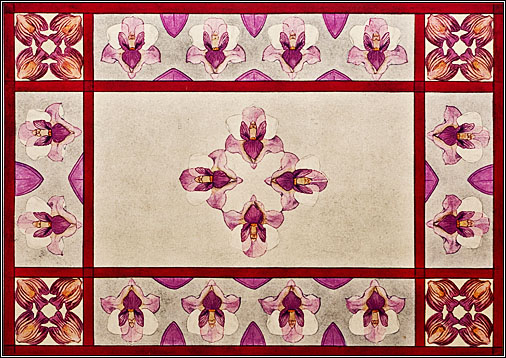 |
Stylization of flowers Bifrenaria harrisoniae Rchb. F. to
form stained-glass windows or carpets - Drawing by M. B. Vecchi.
Drawing shown in "Iconografia das Orchidaceas do Brasil"
as suggestions for introduction of Brazilian orchids in decorative.
|
Summary extracted
from the paper entitled "Frederico Carlos Hoehne: the actuality of
a pioneer in the field of nature protection in Brazil, " published
in 2005, Environment & Society. Vol.8 No. 1, Campinas and also Chapter
IV - Frederico Carlos Hoehne and Nature Conservation in Sao Paulo and
from the book "Nature Protection and Identity National in Brazil
years l920-1940", Published in 2009 by Fio Cruz editora, both of
authored by professors José Luiz de Andrade Franco (*) e José
Augusto Drummond (**)
(*) Doctor in History from the University of Brasilia. Professor, Department
of History at the University of Brasilia and Research Associate of Center
for Sustainable Development at the University of Brasilia.
(**) Ph.D. in Natural Resources and Development at the University of Wisconsin.
Associate Professor, Center for Sustainable Development at the University
of Brasilia.
|